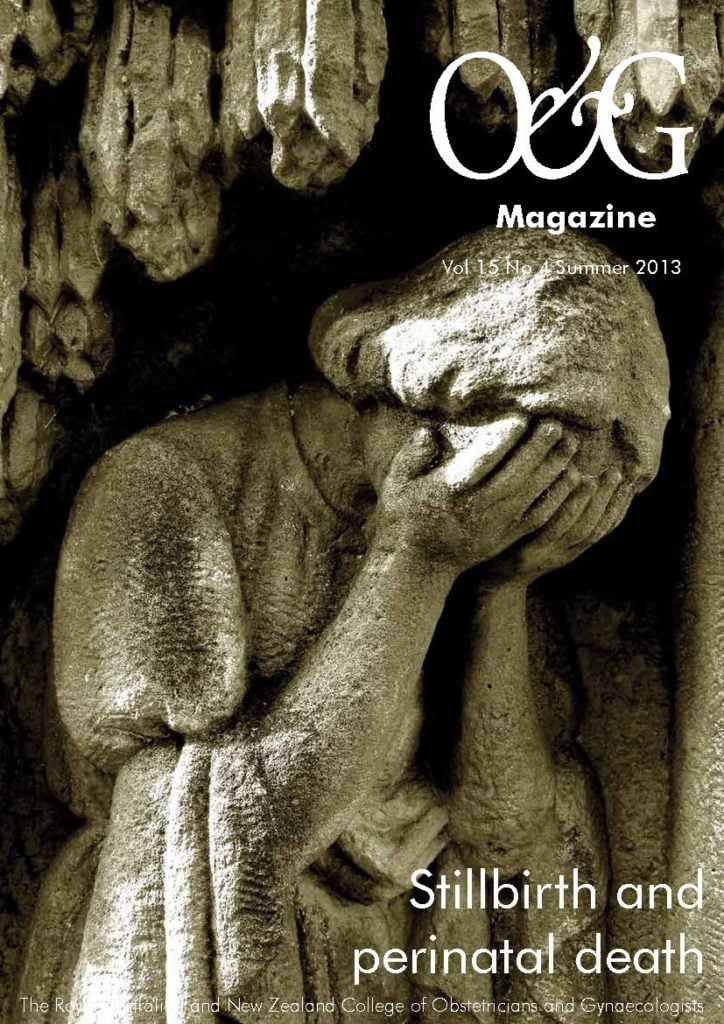An overview of the first eight years of New Zealand’s Perinatal and Maternal Mortality Review Committee.
The Perinatal and Maternal Mortality Review Committee (PMMRC) was established, in 2005, to review and report on all maternal deaths and all deaths of infants born from 20 weeks gestation to 28 days after birth. Now in its eighth year, the committee has established a nationally recognised system of data collection and reporting and made recommendations that have had a positive impact on the quality of maternity care in New Zealand. This article summarises the achievements of the PMMRC and highlights some of the key findings of its latest report released earlier this year.
The PMMRC was initially established as a ministerial committee of the Ministry of Health. In 2011, it was transferred to the Health Quality and Safety Commission, a crown entity with the overarching objective of monitoring and improving the quality and safety of health and disability services and assisting providers across the sector to improve these services. The PMMRC’s role has been clearly defined in the New Zealand Public Health and Disability Act 2000. The committee’s task is to produce strategic plans and methodologies designed to reduce mortality and morbidity in its reporting area.
The PMMRC and its working groups’ members represent the spectrum of maternity care, including obstetrics and gynaecology, midwifery, paediatrics, neonatology, Maori and Pacific health, and consumers. The working groups include the Maternal Mortality Working Group, the Neonatal Encephalopathy Working Group and the Australasian Maternity Outcomes Survedeonillance System (AMOSS) Working Group, who work jointly with the University of New South Wales to collect maternal morbidity data.
The current chair of the Committee is Dr Sue Belgrave, the clinical director of obstetrics at Waitemata District Health Board. Dr Belgrave officially took up this position in June 2013, following on from the founding chair Prof Cindy Farquhar, in the Department of Obstetrics and Gynaecology at the University of Auckland, who has been largely responsible for the development of the work of this committee.
Under the New Zealand Public Health and Disability Act 2000 and Section 88, Lead Maternity Carers are required to provide information to the PMMRC. PMMRC local coordinators within each district health board (DHB) identify perinatal deaths and oversee the collection of the required data. The coordinators are also responsible for initiating local clinical reviews of each case, including assigning classification codes for causes of death, determining contributory factors and potentially avoidable deaths.
An annual report and workshop highlight areas where improvements could be made to the overall maternity system using aggregated national perinatal and maternal mortality and morbidity data. These data analyses have resulted in a number of recommendations on how to improve outcomes for New Zealand mothers and babies over seven annual reports. Some of the achievements of the PMMRC are highlighted below:
- In 2006, a national process was established for clinical data collection from all 20 DHB for all perinatal and maternal deaths. Prior to 2006, perinatal and maternal mortality analysis was solely based on routinely collected administrative data. A network of local DHB coordinators remains central to the success of this committee. This methodology led to an increase in ascertainment of deaths. While this led to accurate and robust reporting, it also led to an increase and apparent deterioration in rates compared to jurisdictions relying on routine data collection.
- There is now a well-established methodology for reporting potentially avoidable perinatal and maternal deaths that is multidisciplinary and can be used to identify areas for improvement in clinical care. The three domains are: management and organisation of services; knowledge and skills of personnel; and barriers to accessing or engaging with care.
- The committee has consistently raised awareness of the poor state of maternal and perinatal mental health services and, as a result, a review was undertaken by the Ministry of Health and in 2012 a report, Healthy Beginnings1, recommended a number of measures to improve these services. New funding for the recommendations of this report was announced in the 2013 Health Budget.
- A detailed external review was undertaken of the maternity services in Counties Manukau DHB, which was found to consistently have a perinatal mortality rate above the national average. This review resulted in ten wide-ranging recommendations that are currently being implemented.2
- The Ministry of Health’s maternity quality and safety program, launched in 2011, and the establishment of the National Maternity Monitoring Group in 2012, were informed by the work of the PMMRC. The quality and safety program addresses many aspects of maternity care, including improving maternity records, developing a national electronic maternity record, establishing standards for provision of healthcare, developing clinical governance processes and a requirement for DHBs to improve access to maternity care for all women.
- National guidelines have been commissioned by the Ministry of Health including referral guidelines, management of massive blood loss, gestational diabetes and observation of the newborn.
Report findings
The latest annual report (published in June 2013)3 analysed perinatal mortality over five years (2007–11) and maternal mortality over six years (2006–11). In addition, the PMMRC is increasing its work in the area of morbidity, with analysis of neonatal encephalopathy (2010–11) and maternal morbidity (2010–11).
The maternal mortality ratio was 15.7 per 100 000 maternities in the years 2009–11, not significantly different from 18.2 per 100 000 in 2006–08. From 2006 to 2011, the most common causes of maternal death in New Zealand were pre-existing medical conditions (23 per cent) and suicide (22 per cent). Thirty-five per cent of maternal deaths were identified as potentially avoidable, with similar contributions from organisation and management factors, personnel factors and barriers to access, and engagement with care.
The 2012 report noted a reduction in the perinatal related death rate using the World Health Organisation (WHO) international definition of birthweight ≥1000g, when lethal and terminated congenital abnormalities are excluded.4 Further, there was a significant reduction in term intrapartum deaths and hypoxic peripartum deaths from 2007–11.
There has, however, been a significant increase in perinatal related mortality of babies born in multiple births, from 32 per 1000 births in 2007, to 53 per 1000 births in 2011. The committee has recommended all women having assisted reproduction, such as in vitro ferilisation, be offered transfer of a single embryo, rather than two or more.
In 2011, aggregation of data from local DHB mortality review showed 19 per cent of perinatal deaths were potentially avoidable. The most common contributing factors to these deaths were barriers to access or engagement with care – most commonly, late or infrequent access to antenatal care. These were followed by personnel factors – most commonly, failure to follow recommended best practice.
Maori, Pacific and Indian mothers as well as women from areas of socioeconomic deprivation were significantly more likely to experience a perinatal death. The risks of losing a baby from potentially avoidable causes were higher for Maori and Pacific mothers, and for women from areas of socio-economic deprivation.
An audit of babies who died in 2010 at 20 weeks or beyond with screen-detectable congenital abnormalities, found that one woman in four who sought care with a primary healthcare provider before 20 weeks gestation was not offered first- or second-trimester antenatal screening. The PMMRC has recommended that all GPs and midwives should be adequately informed to be able to offer antenatal screening.
While there was poor documentation of whether women took folic acid around the start of pregnancy, it appears not all pregnant women are taking folic acid to prevent birth defects. The PMMRC data suggest that as many as 15 deaths in one year associated with neural tube defects, such as spina bifida, could be prevented with folic acid. Therefore, the PMMRC recommends the fortification of bread with folic acid.
Establishing a national committee and a robust methodology for ascertainment and data collection of perinatal and maternal mortalities has resulted in an accurate estimate of the burden of perinatal and maternal mortality in New Zealand, and a greater understanding of the contributors to mortality and will lead to further improvements in outcomes.
New report available
The Health Quality and Safety Commission has released its report on serious adverse events reported by DHBs and a number of other providers in 2012–13. The report looks at events affecting health and disability consumers that reach the threshold for reporting as Severity Assessment Criteria (SAC) events SAC 1 and 2. It is the first report by the Commission that includes events reported by providers other than DHBs. The full report and a summary are available on the Commission’s website at: www.hqsc.govt.nz/our-programmes/reportable-events/publications-and-resources/publication/1190/ .
References
- Ministry of Health. Healthy Beginnings: Developing perinatal and infant mental health services in New Zealand. Wellington: Ministry of Health; 2011.
- Paterson, R., Candy, A., Lilo, S., McCowan, L., Naden, R., O’Brien, M. External Review of Maternity Care in the Counties Manukau District. Auckland: Counties Manukau District Health Board; 2012.
- PMMRC. Seventh Annual Report of the PMMRC: reporting mortality 2011. Wellington: Health Quality & Safety Commission; 2013.
- WHO Library Cataloguing-in-Publication Data. Neonatal and perinatal mortality: country, regional and global estimates. Geneva: World Health Organization; 2006. URL: http://whqlibdoc.who.int/publications/2006/9241563206_eng.pdf (accessed 11 October 2013).








Leave a Reply